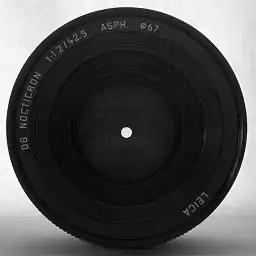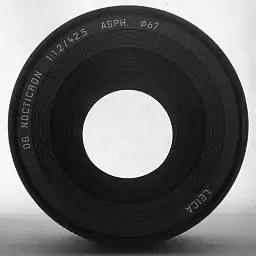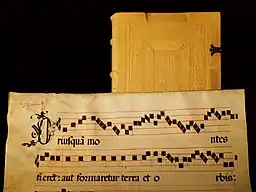 | |
| Maker | Panasonic |
|---|---|
| Lens mount(s) | Micro Four Thirds |
| Technical data | |
| Type | tele prime |
| Focus drive | stepper |
| Focal length | 42.5 mm |
| Focal length (35mm equiv.) | 85 mm |
| Crop factor | 2 |
| Aperture (max/min) | f/1.2 / f/16 |
| Close focus distance | 0.5 m |
| Max. magnification | 0.1 |
| Diaphragm blades | 9, circular |
| Construction | 14 elements in 11 groups |
| Features | |
| Ultrasonic motor | |
| Weather-sealing | |
| Lens-based stabilization | |
| Macro capable | |
| Unique features | aspheric / dual image stabilisation |
| Application | portrait / night shots |
| Physical | |
| Max. length | 77 mm |
| Diameter | 74 mm |
| Weight | 425 g |
| Filter diameter | 67 mm |
| Accessories | |
| Lens hood | included |
| Case | included |
| History | |
| Introduction | 2014 |

Nocticron („Night-time“ from latin nox, noctis „night“ and ancient Greek kronos „time“[1]) is the brand name of Leica lenses with an extreme speed of f/1.2. Because of the large aperture size and its image stabilisation system it is possible to take images with relatively short exposure time especially in available light situations. Together with the high number of nine diaphragm blades the lens creates a strong and pleasant bokeh.
Market position
Nocticron lenses are slower than Noctilux lenses (f/0,95 or f/1,0) and faster than the Leica-lenses with the brand name Summilux (f/1,4), Summicron (f/2,0) and Elmarit (f/2,8).
Description
Nocticron prime lenses are offered as exchangeable lenses for the Micro Four Thirds system (MFT). At photokina 2012 the model Lumix Leica DG Nocticron 1:1,2/42.5 mm ASPH[2] was announced, and it is available since 2014.
Leica lenses with the model name attribute DG are made by Panasonic under license.
The lens has a smooth focusing ring as well as a clicked aperture ring. It is relatively large and heavy, and is not water or dust proof.
The anti-reflective coating of the telephoto lens with 1.7 times normal focal length has 14 lenses in 11 groups, two of them aspheric and another with extremely low dispersion. The front lens is made of extremely high refracting glass. The Nocticron has an excellent image quality.[3]
The Nocticron lenses allow a fast lens-body communication for autofocusing with its rather silent stepper motor, due to the large aperture size also at low light conditions.[4]
- Minimum and maximum aperture
 Minimum aperture of the Noctricron 42.5 mm (F-number 16)
Minimum aperture of the Noctricron 42.5 mm (F-number 16) Maximum aperture of the Noctricron 42.5 mm (F-number 1,2)
Maximum aperture of the Noctricron 42.5 mm (F-number 1,2)
Image stabilisation
As of March 2023, while there are other f/1.2 autofocus lenses,[5] it is still the fastest lens with both image stabilisation and autofocus.[3]
The optical image stabilisation of the lens can even be combined with the opto-mechanical image stabilisation systems of some camera bodies of the system (Dual Image Stabilisation = Dual I.S.).[6] The ‘’Dual I.S.’’ mode can be used only if the firmware of the Nocticron has version 1.2 or higher.[7][8]
Gallery
The following images show some extraordinary capabilities of the Nocticron such as at low light, at high speed, for strong bokeh or with image stabilisation.
- Images taken with a Nocticron, focal length = 42.5 mm, F-number = 1.2
 Still life with parchment and book in candle light, ISO speed = 200, exposure time = 1.3 s, exposure value = -1. The illuminance level on the parchment was below 1 lux.
Still life with parchment and book in candle light, ISO speed = 200, exposure time = 1.3 s, exposure value = -1. The illuminance level on the parchment was below 1 lux. Rose with water drops in sun light, ISO speed = 200, exposure time = 1/8000 s, exposure value = 12.5.
Rose with water drops in sun light, ISO speed = 200, exposure time = 1/8000 s, exposure value = 12.5. Wheat field in strong wind with bokeh, ISO speed = 200, exposure time = 1/4000 s, exposure value = 11.5.
Wheat field in strong wind with bokeh, ISO speed = 200, exposure time = 1/4000 s, exposure value = 11.5. Free-hand taken museum shot of a historic universal theodolite in a display case with transparent glass taken with a polarizing filter, ISO speed = 800, exposure time = 1/8 s, exposure value = 0.5.
Free-hand taken museum shot of a historic universal theodolite in a display case with transparent glass taken with a polarizing filter, ISO speed = 800, exposure time = 1/8 s, exposure value = 0.5.
Comparison
Compared to other camera systems with differing normal focal lengths, and therefore different image sensor sizes, the following equivalent values apply to lenses with appropriate properties as the Nocticron 42,5 mm 1,2 within the Micro-Four-Thirds system (MFT). With the parameters given in the table in all camera systems the photographer will get the same angle of view, depth of field, diffraction limitation and motion blur:
| Image sensor format | Focal lengths at the same angle of view (diagonal angle ≈ 29°) |
F-number at the same depth of field and diffraction limitation |
ISO speed at the same exposure time |
|---|---|---|---|
| Nikon CX | 31 mm | 0.85 | 100 |
| MFT | 42.5 mm | 1.2 | 200 |
| APS-C | 57 mm | 1.6 | 360 |
| Full frame | 85 mm | 2.4 | 800 |
External links
References
- ↑ Howard Cornelsen : New Leica Lens for Micro 4/3, The online Photographer, 2 August 2013, retrieved 23 October 2015
- ↑ Panasonic formally launches Leica DG Nocticron 42.5mm F1.2 ASPH, dpreview.com, 6 January 2014, retrieved 23 October 2015
- 1 2 William Brawley: Panasonic 42.5mm f/1.2 ASPH POWER OIS LEICA DG NOCTICRON (Tested), SLRgear Review, 16 January 2014, retrieved 23 October 2015
- ↑ Gordon Laing: Leica Nocticron 42.5mm f1.2 review, cameralabs.com, January 2014, retrieved 12 November 2016
- ↑ "Shop Camera Lenses: Zuiko Lenses & Lens Kits | Olympus Cameras, Audio & Binoculars".
- ↑ Gordon Laing: Leica Nocticron 42.5mm f1.2 - verdict and scores, cameralabs.com, January 2014, retrieved 23 October 2015
- ↑ Panasonic issues lens firmware updates to enable Dual I.S. with Lumix DMC-GX8, dpreview.com, 10 August 2015, retrieved 23 October 2015
- ↑ Update Contents for H-NS043, support.panasonic.com, 5 August 2015, retrieved 23 October 2015